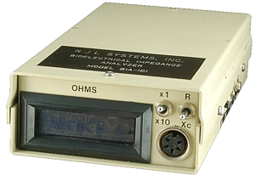biolectrical impedance analysis
What is BIA?
Bioelectrical impedance analysis is the study of the electrical properties of biological material and its change over time. This includes humans, animals, fish, plants, vegetables, fruits and anything living. Even human circulation and breathing can be quantified with a real-time BIA instrument that has enough sensitivity and a short sampling interval[1].
The most popular application for BIA is predicting human body composition as a total body measurement from hand to foot where resistance and reactance are evident from a biological circuit that conducts alternating current. The source electrodes introduce an alternating current (50 Khz) at the base of the toes and fingers. The detecting electrodes measure the voltage drop due to this circuit at the anatomical land marks of the ankle and wrist bones. This is a four electrode, or tetrapolar measurement, which is optimal to eliminate electrode and field distribution problems associated with two electrode measurements. The conducting media has a resistive and capacitive electrical path. These two values are independently measured and resolve the cellular and ionic components of the material. The cellular volume is measured as capacitive reactance and the resistive volume as ionic resistance, both of which are expressed in ohms. Modeling these two values as their series or parallel equivalent circuits is important when comparing them to criterion methods.
1. Nyboer, J.: Electrical Impedance Plethysmography. Second Edition. Charles C. Thomas, Springfield, IL, 1970.

The very first BIA, developed for the Mount McKinley project in 1981, measured electrical resistance and reactance at 50 Khz, and used rechargeable batteries. The basic specifications of today’s Bioelectrical Impedance Analyzers are fundamentally the same as those of the original project. Every instrument manufactured by RJL Systems incorporates passive isolation for safety, accuracy and repeatability. Some BIA-101 analyzers are still in use after more than 20 years.
About BIA
BIA, or bioelectric impedance analysis, is a fast, accurate and safe way to measure six key body composition elements. Through the study of the electrical properties of the body and their changes over time, health professionals can easily measure clients’ overall health and quickly chart their progress. BIA analysis is quick, painless and completely non-invasive, using four electrodes placed on the body: no needles or bloodwork required.
BIA can be performed on any living thing: humans, animals and even plants. It can be used in clinical, educational or research settings. Body composition assessment provides healthcare professionals and their clients with a powerful, accurate window into disease and health.
History of BIA
The first application of BIA occurred on Mount McKinley, Alaska in 1981. Dr. William Mills MD, an Admiral in the US Navy, initiated a study to assess the hydration status of soldiers in high altitude, cold weather environments. There was one reference paper by Hoffer[1] in 1969 that indicated a hand to foot whole body BIA measurement could predict total body water. With the encouragement of Jan Nyboer MD, Dsc the Mount McKinley soldier hydration project was started.
Four BIA instruments were ordered by the US Navy from RJL Systems that had to be designed and built to handle the cold weather on top of Mount McKinley. The instruments were applied to soldiers along with analyzing samples of blood and urine at approximately 10,000 feet. Electrode placement was the same as is used today. The dollar amount of the Navy contract was enough to put months of research and development into designing an accurate, dependable, and safe instrument that could be used on humans.
The results of BIA measurements compared to blood and urine analysis were very encouraging. This inspired RJL Systems to build additional instruments for scientific research. Shortly thereafter, Hank Lukaski[2] at the USDA in Grand Forks, ND was one of the first to publish a paper on BIA and body composition. Today there are thousands of papers and abstracts on BIA to predict body composition.
1. Hoffer, E.C., Meador, C.K. and Simpson, D.C.:Correlation of whole body impedance with total body water volume. J. Appl. Physiol., 27: 531, 1969.
2. Lukaski, H.C., Johnson, P.E., Bolonchuk, W.W., Lykken, G.I.: Assessment of fat free mass using bio-electrical impedance measurements of the human body Am. J. Clin. Nutr., 41: 810-817, 1985.
The Future of BIA
BIA science is evolving from a statistical machine for assessing body composition to a diagnostic tool that may someday be used to illustrate the progress of disease and health. It took 50 years for electrocardiography to be where it is today from when first developed by Willem Einthoven in 1901. BIA will likely follow the same path.
